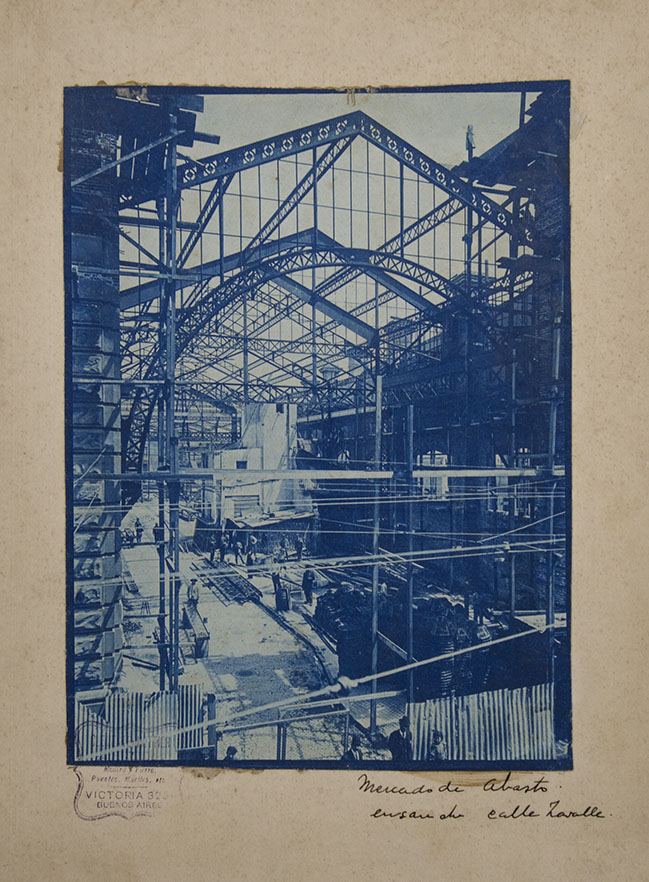Abasto Market.
Lavalle Street widening. Buenos Aires. Circa 1890
Vintage cyanotype -measures: 17.5 x 23.8 cm / 6.88 x 9.37 in- mounted on a cardboard or secondary support with the period handwritten reference and a wet stamp of the construction firm at the bottom. The work is in good condition and is displayed framed.
The old process known as cyanotype was widely used by photographers focused on architectural records -we emphasize the pioneering nature of the Argentine photographer Adolfo Gerónimo Ramón Alexander (1857-1931)- or in the great works of road, railway, nautical engineering, etc.
As an example of what has been said, we present this work done by an unidentified professional photographer and directly commissioned by the construction company. In this case the camera operator was located at a certain height, precisely to cover all the works in a panoramic type registry. The shot is somewhat artistic, if we take into account the interweaving of parallel lines, angles and arches produced by the different iron beams in the construction of the large roof of this industrial building.
We must point out that the demolition of the traditional "Mercado Modelo" -due to the opening of Avenida de Mayo (1894)- located in front of Lorea Square, together with the great demographic and economic growth of the city of Buenos Aires towards the end of the 19th century, urgently demanded the construction of a new concentrating Supply Market to serve a rapidly growing population and with other ranges of consumption, driven in part by the eating habits of the large European immigration.
A piece of land -acquired in the mid-1870s by the Devoto brothers- was the basis of the petition presented to the Buenos Aires Deliberative Council, which sanctioned the ordinance authorizing the construction of the "Central Market of Supply" on January 8, 1889. The surface included the block limited by Corrientes, Lavalle, Anchorena and Laprida streets. The works began around 1890 and three years later inaugurated a first part of the large building of masonry, iron and glass, with an area of 1,300 m2. From that date the popular neighborhood of Balvanera was invaded by the bustle of the bustling market, to which was added the incessant traffic of carts full of fruits and vegetables, many from suburban farms.
From that founding stage only a few testimonies remain, such as this important blueprint documentary photograph, which was made at the specific request of the company directed by the French Clemente Hottier: "Builder of bridges, docks, and annexed works - Calle 3231 Victoria Street, Buenos Aires”, as indicated by the advertising of the time printed on a wet stamp in black ink located on the lower left edge.
We must point out that the process of cyanotype or copy to ferroprusside was also used for copying architectural plans, as they were revealed thanks to sunlight. This monochrome printing system was invented around the year 1842 by the Englishman Sir John Herschel (1792-1871) and its prints are characterized by a Prussian blue or turquoise hue; in this special process the silver salts are replaced by iron salts that give it this special tonality. S.O.VI-OIM
| AUTHOR | FOTÓGRAFO NO IDENTIFICADO |
|---|
Are you interested in selling some works?
Send us an email briefly indicating
which works you intend to put on sale, and we will respond. click here
Subscribe to our newsletter to be updated.
Check our Newsletters